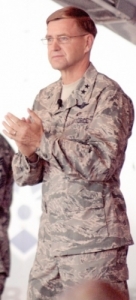Hoog: 4th still first
By Kenneth Fine
Published in News on November 10, 2010 1:46 PM

News-Argus/MICHAEL K. DAKOTA
9th Air Force Commander Maj. Gen. Stephen L. Hoog applauds Seymour Johnson Air Force Base airmen for earning a satisfactory rating during the recent Operational Readiness Inspection conducted by Air Combat Command officials at the installation.
From the skies over Afghanistan to the Goldsboro Air Force base they call home, members of the 4th Fighter Wing are living up to the legacy that has been written and reinforced by generations of men and women since World War II -- at least as far as Maj. Gen. Stephen Hoog is concerned.
So when the 9th Air Force commander spoke Tuesday about just how the global war on terror -- and the American airman's role in it -- is changing, he kept coming back to just how impressed he has been with the spirit of those who make their way onto Seymour Johnson Air Force Base every day.
"In our business, every once in a while you get the sense that some folks are just treading water -- trying to keep their heads above water. That's not what I see here at all," he said. "We're doing it downrange. We're doing it here. ... So I wouldn't just say they are on the ball. I would say that this Seymour Johnson team, writ large, is doing some incredible things."
Like in Afghanistan, where more than 700 members of the 4th are currently providing 24/7 air support to Allied troops on the ground -- ensuring that the aging aircraft they brought to the fight are always fit to fly.
"The young men and women we have working on those airplanes are second to none," Hoog said. "What all the airplanes bring, and probably the F-15 in some ways more because of its long range and endurance, is the ability to do a number of things that change the nature of the fight on the ground."
And that fight, the general added, is changing.
For Strike Eagle air crews, the mission stretches far beyond relentless bombing campaigns seen in previous wars, he said.
In fact, dropping ordnance has become a last resort.
"A lot of times, all the guys on the ground need is ... situation awareness -- a view from above ... and every F-15E has a targeting pod on it so that ... now, all of a sudden, the commander on the ground has got a God's eye view," Hoog said. "That's a subtle but key change. I mean, who would have thought that one of the primary missions (of the F-15E) is to bring ... full motion video to the ground commander?"
Shows of force are equally important.
"Just ... to hear the circling of the planes in the background is enough to change the dynamics and change the behavior of people on the ground," the general said.
But sometimes, sheer intimidation doesn't work.
And luckily, Hoog said, 4th air crews are among those currently firing when needed.
"They are using the capabilities of the F-15E to deliver precise ordnance when and where it's needed," he said. "With ... minimal collateral damage."
Those pilots and weapons system officers, though, can only carry the legacy of the wing so far.
Hoog said it himself.
So he takes pride in knowing that every 4th airman, despite his or her career field, is excelling.
"(The maintainers) are doing more with older airplanes. We are flying harder than we planned. Every month that an F-15E spends down range, it flies the equivalent of seven months of flying," Hoog said. "But (the maintainers) have stepped up to the challenge."
And the support personnel, civil engineers, Security Forces and medics, too, have delivered in theater time and time again.
So he welcomes the role he took on a few months ago as the man in charge of the "big picture."
And he urges those leaders he comes across at different bases to recognize the sacrifice each who wears the uniform makes.
"These are great men and women who have taken an oath to serve their country," Hoog said. "So we need to make sure that when they come back (from a deployment), they understand that the time they spent down range, the time they spent away from their families, is valued by their nation, by their peers and by their superiors."
The 4th, though, doesn't seem to need a reminder, he said -- nor does the community that houses Seymour Johnson.
"What really makes a difference is the way the community supports the airmen. Do they take care of the airmen downtown? Are they welcoming in the community itself?" he said. "The question we ask, primarily, is, 'Are they taking care of the airmen? And the answer here is unequivocally yes. ... I don't think I've ever seen this kind of support from a community."
So as his brief stint at Seymour Johnson came to an end, Hoog didn't need much time to field a question about whether recent successes -- both in Afghanistan and at home, where members of the wing were just declared combat ready by Air Combat Command inspectors -- prove that the 4th is living up to the standards set by those who have come before the men and women currently stationed in Goldsboro.
"Unmistakably yes," he said.
